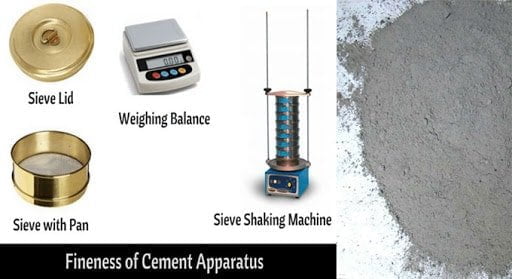Table of Contents
1. Introduction
Cement is an important type of construction material that is necessary for almost all types of civil engineering works. Cement is the main material of concrete technology and construction. Cement can be defined as the binding material having both cohesive and adhesive properties thereby capable of bonding the mineral fragments into a compact mass. Due to the immense importance of cement in the strength and durability of the structures, it is necessary to ascertain the quality of cement being used. Hence, several tests have to be conducted to ensure the quality of the cement. One such quality control test of cement is the Fineness test.

The fineness test of cement is a simple test that involves the determination of the fineness of the cement simply by sieving the cement.
In general, the test includes the determination of the weight of the cement particles whose size is greater than 90 microns and thus the percentage retained is computed.
2. Importance of Fineness Test of Cement
Cement undergoes hydration upon the addition of water to it.
Generally, when water is added to the cement, a thin layer is developed around the cement particles. This layer eventually grows bigger and the cement tends to separate. This process causes the hydration to slow down.
Hence, the smaller particles of cement react more quickly than the larger cement particles.
In actual practice, it has been found that the particle with a 1µm diameter will react entirely in one day whereas the particle with a 10µm diameter takes about a month. Hence, the particle size distribution of cement is a critical factor that affects the final strength gained by the cement within the allowable.
However, excessive smaller particles in cement result in a quick setting, leaving no time for mixing, handling, and placing.
Thus, to increase the setting time of cement, cement must be ground in various ranges of particle sizes.
In general practice the cement proportion used is approximately 10% of the cement of fine particles that is smaller than 2 µm, 10% of the weight of cement is made of particles larger than 50 µm, and only a few percent of weight is made of particles larger than 90 µm.
3. General Test Procedure of Fineness Test of Cement
The general procedure of the fineness test has been briefly discussed below.
a. Apparatus Required
1. Weighing Balance with an accuracy of 1mg.
2. Sieve pan along with the lid.
3. Standard Sieve of size 90 µm.
4. Sieve Shaking Machine(optional)
b. Procedure
The test procedure of the fineness test of cement includes the following series of steps:
1. The cement sample is first taken and rubbed with hands to ensure the cement sample is free of lumps.
2. About 100g of the cement sample is taken and duly weighed (W1).
3. Then, the 100g of cement taken is poured into the 90 µm sieve and the lid is closed.
4. The sieve with the sample is placed in the Sieve shaking machine for about two minutes. The shaking of the sieve may also be done by hands by agitating the sieve in planetary and linear movements for approximately 15 minutes.
5. The residue left over after the completion of sieving is then weighed (W2).
6. Then, the percentage of the weight of cement-retained on the sieve is computed using the following formula,
% of cement-retained on the sieve = (W2/W1) * 100
7. The above-mentioned steps are again repeated with three different samples of cement and the average of the values obtained is taken for accurate results.
c. Observation & Calculation
| Sr.No. | Weight of Cement Sample | Weight Cement Sample Retained on 90µm Sieve | Fineness of Cement |
| 1 | 100 gm | 4.65 | 4.65 % |
| 2 | 100 gm | 8.25 | 8.25 % |
| 3 | 100 gm | 7.95 | 7.95 % |
| Average | 6.95 % |
d. Result
The cement is considered good cement if 10% of the weight of the cement is retained when sieved through a 90 µm sieve.
e. Precautions of Fineness Test of Cement
a. Sieving procedure should be done carefully by rotating the sieve rather than translation to take accurate readings after repeating the process multiple times.
b. Lumps free cement should be used for sieving by breaking lumps of cement with hands or clean dry rods.
| Read More: Core Cutter Method |
| Read More: Striping Value Test on Aggregates |

